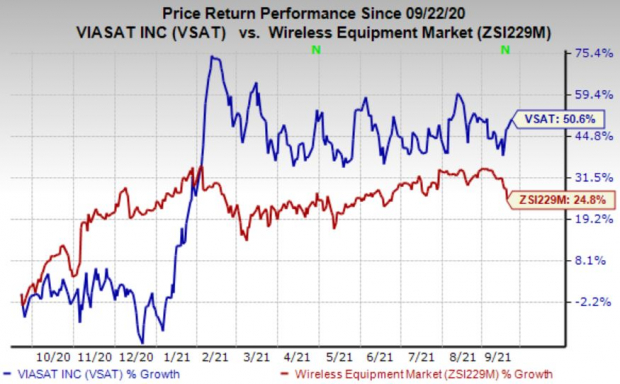Viasat, Inc. VSAT has secured two research contracts from the U.S. Department of Defense (“DoD”) to evaluate the potential and feasibility of 5G connectivity in the battlefield. The Carlsbad, CA-based company has been working with DoD to address challenging communications issues across multiple network domains.
The research contracts, which will be conducted over a span of three years, were awarded through the Information Warfare Research Project. These contracts are part of the $600 million 5G research program that was announced last year by DoD. The initiative aims to assess how the fifth-generation technology can boost warfighting capabilities.
With the exponential growth of the 5G networks globally, the need for an advanced communications infrastructure even in the battle zone holds utmost importance. Viasat is working with U.S. armed forces to explore the benefits of 5G bandwidth and connectivity for bases and mobile platforms at the tactical edge to not only boost multi-domain operations but also enable joint force operations, thereby improving situational awareness.
The contracts focus on two key areas — 5G enhanced network deployment for Agile Combat Employment operations in extreme environments and improving Command and Control (C2) applications and services. The first research area relates to providing C2 hardware packages that bolster command, control, communications, computers, intelligence, surveillance and reconnaissance (C4ISR), cybersecurity and networking software.
Through the second research scope, Viasat intends to scout for ways that will help in achieving swift deployment of secure 5G nodes at the tactical edge. The company will also test 5G resiliency in warfighting operations through bandwidth-intensive applications such as ISR mapping.
To conduct these research experiments, Viasat intends to leverage its System Integration Lab, NetAgility product, and Expeditionary Lightweight Integrated Tactical Edge Kit solution with a 5G gateway. These state-of-the-art platforms will enable network dimensioning and provide DoD multi-path transport and network management support with adequate backing for C2 application experiments.
Apart from these trailblazing solutions, the satellite broadband services provider will build 5G digital twin model to analyze rapid network configuration while addressing high bandwidth requirements. Given the company’s long-standing relationship with the U.S. DoD, the latest achievement is expected to generate new revenue streams, thereby indicating a healthy potential for Viasat’s growth in the long run.
The Zacks Rank #3 (Hold) stock has gained 50.6% compared with the industry’s growth of 24.8% in the past year.

Image Source: Zacks Investment Research
Some better-ranked stocks in the industry are InterDigital, Inc. IDCC, Clearfield, Inc. CLFD, and Juniper Networks, Inc. JNPR, each sporting a Zacks Rank #1 (Strong Buy). You can see the complete list of today’s Zacks #1 Rank stocks here.
InterDigital delivered a trailing four-quarter earnings surprise of 536%, on average.
Clearfield delivered a trailing four-quarter earnings surprise of 49%, on average.
Juniper delivered a trailing four-quarter earnings surprise of 7.5%, on average.
5 Stocks Set to Double
Each was handpicked by a Zacks expert as the #1 favorite stock to gain +100% or more in 2021. Previous recommendations have soared +143.0%, +175.9%, +498.3% and +673.0%.
Most of the stocks in this report are flying under Wall Street radar, which provides a great opportunity to get in on the ground floor.
Today, See These 5 Potential Home Runs >>Want the latest recommendations from Zacks Investment Research? Today, you can download 7 Best Stocks for the Next 30 Days. Click to get this free report
Juniper Networks, Inc. (JNPR): Free Stock Analysis Report
InterDigital, Inc. (IDCC): Free Stock Analysis Report
Viasat Inc. (VSAT): Free Stock Analysis Report
Clearfield, Inc. (CLFD): Free Stock Analysis Report
To read this article on Zacks.com click here.
Zacks Investment Research
The views and opinions expressed herein are the views and opinions of the author and do not necessarily reflect those of Nasdaq, Inc.


